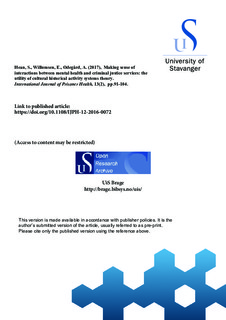| dc.contributor.author | Hean, Sarah | |
| dc.contributor.author | Willumsen, Elisabeth | |
| dc.contributor.author | Ødegård, Atle | |
| dc.date.accessioned | 2018-01-18T13:48:34Z | |
| dc.date.available | 2018-01-18T13:48:34Z | |
| dc.date.created | 2017-07-14T13:29:03Z | |
| dc.date.issued | 2017-01 | |
| dc.identifier.citation | Hean, S., Willumsen, E., Ødegård, A. (2017) Making sense of interactions between mental health and criminal justice services : the utility of cultural historical activity systems theory. International Journal of Prisoner Health, 13(2), pp. 91-104 | nb_NO |
| dc.identifier.issn | 1744-9200 | |
| dc.identifier.uri | http://hdl.handle.net/11250/2478177 | |
| dc.description.abstract | Purpose
Effective collaboration between mental health (MHS) and criminal justice services (CJS) impacts on mental illness and reduces reoffending rates. This paper proposes the Change Laboratory Model (CLM) of workplace transformation as a potential tool to support interagency collaborative practice that has potential to complement current integration tools used in this context. The paper focuses specifically on the theoretical dimension of the model: the cultural historical activity systems theory (CHAT) as a theoretical perspective that offers a framework with which interactions between the MHS and CJS can be better understood.
Approach
The structure and rationale behind future piloting of the change laboratory in this context is made. Then CHAT theory is briefly introduced and then its utility illustrated in the presentation of the findings of a qualitative study of leaders from mental heath and criminal justice services that explored their perspectives of the characteristics of collaborative working between mental health and prison/probation services in a Norwegian context and using CHAT as an analytical framework.
Findings
Leaders suggested that interactions between the two services, within the Norwegian system at least, are most salient when professionals engage in the reintegration and rehabilitation of the offender. Achieving effective communication within the boundary space between the two systems is a focus for professionals engaging in interagency working and this is mediated by a range of integration tools such as coordination plans and interagency meetings. Formalised interagency agreements and informal, unspoken norms of interaction governed this activity. Key challenges limiting the collaboration between the two systems included resource limitations, logistical issues and differences in professional judgments on referral and confidentiality.
Original value
Current tools with which MHS/CJS interactions are understood and managed, fail to make explicit the dimensions and nature of these complex interactions. The CLM, and CHAT as its theoretical underpinning, has been highly successful internationally and in other clinical contexts, as a means of exploring and developing interagency working. It is a new idea in prison development, none as yet being applied to the challenges facing the MHS and CJS. This paper addresses this by illustrating the use of CHAT as an analytical framework with which to articulate MHS/CJS collaborations and the potential of the CLM more widely to address current challenges in a context specific, bottom-up and fluid approach to interagency working in this environment.
| nb_NO |
| dc.language.iso | eng | nb_NO |
| dc.publisher | Emerald | nb_NO |
| dc.subject | mental health | nb_NO |
| dc.subject | mental helse | nb_NO |
| dc.subject | fengselssystemet | nb_NO |
| dc.subject | fengselsbetjenter | nb_NO |
| dc.subject | relational coordination | nb_NO |
| dc.title | Making sense of interactions between mental health and criminal justice services : the utility of cultural historical activity systems theory | nb_NO |
| dc.type | Journal article | nb_NO |
| dc.description.version | submittedVersion | nb_NO |
| dc.rights.holder | © Emerald Publishing Limited 2017 | nb_NO |
| dc.subject.nsi | VDP::Social science: 200 | nb_NO |
| dc.source.pagenumber | 91-104 | nb_NO |
| dc.source.volume | 13 | nb_NO |
| dc.source.journal | International Journal of Prisoner Health | nb_NO |
| dc.source.issue | 2 | nb_NO |
| dc.identifier.doi | 10.1108/IJPH-12-2016-0072 | |
| dc.identifier.cristin | 1482271 | |
| cristin.unitcode | 217,7,3,0 | |
| cristin.unitcode | 217,7,4,0 | |
| cristin.unitname | Institutt for sosialfag | |
| cristin.unitname | Handelshøgskolen ved UiS | |
| cristin.ispublished | false | |
| cristin.fulltext | preprint | |
| cristin.qualitycode | 1 | |
